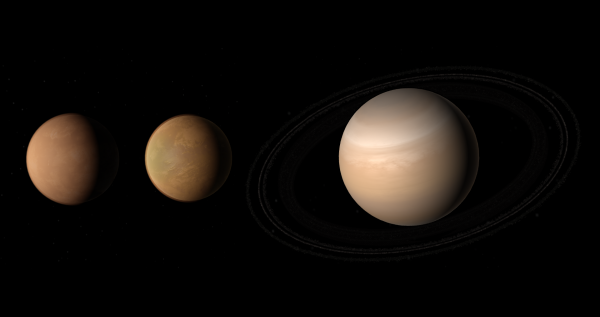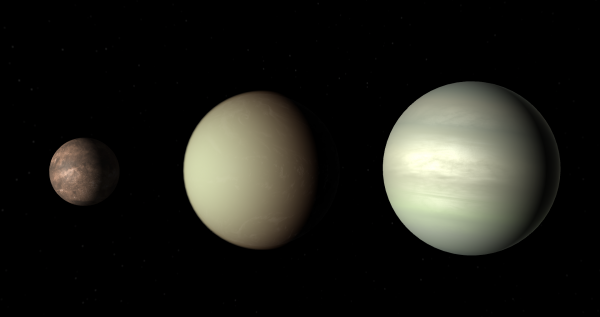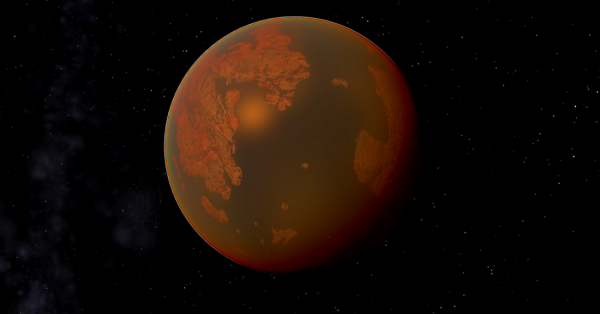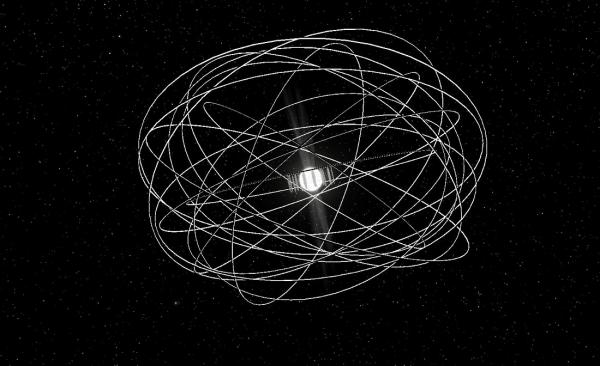BY LETTER
Wasat (Delta Geminorum)
Galactography > Regions of Space > Inner Sphere
Galactography > Systems and Worlds > Systems & Worlds W - X
Galactography > Systems and Worlds > Systems & Worlds W - X
 Image from Dangerous Safety | |
| The planets orbiting Wasat; Atlas, Globe and Mappa | |
Wasat System - Data Panel | |
| System | Names: Wasat, Delta Geminorum Components: 3 1) Wasat (Delta Geminorum Aa) 2) Geographia (Delta Geminorum Ab) 3) Tianzun (Delta Geminorum B) Location: - Distance from Conver Ky: 6.565 ly (J2000) - Distance from Sol: 56.487 ly (J2000) - Constellation: Gemini (J2000) |
|---|---|
| Wasat | Names: Wasat, Delta Geminorum Aa, 55 Geminorum Aa, Gliese 271 Aa (GJ 271 Aa), HD 56986, HIP 35550, HR 2777 Physical characteristics: - Mass: 1.57 x Sol - Radius: 2.674 x Sol - Luminosity: 10.146 x Sol (bolometric) - Temperature: 6,300 Kelvin - Spectral type: F0 IV - Age: 1.6 billion years System: Surrounding Wasat was a small number of vulcanoid asteroids which were disassembled for the construction of starlifting apparatuses fueling the development of the system. In the Current Era, the circumstellar environment is dominated by a large number of ringworlds. They are not the sole occupiers of the circumstellar space, however; billions of smaller habitats are also present. |
| Geographia | Names: Geographia, Delta Geminorum Ab, 55 Geminorum Ab, GJ 271 Ab Physical characteristics: - Mass: 0.186 x Sol - Radius: 0.224 x Sol - Luminosity: 0.004 x Sol (bolometric) - Temperature: 3,052 Kelvin - Spectral type: M4 V - Age: 1.6 billion years System: Aside from the vulcanoids, a dwarf planet known as Library also orbits this star. Most vulcanoids were disassembled over the last few millennia for additional materials for the construction of structures around Wasat and Geographia itself. Library, now a shellworld, along with few remaining vulcanoids, currently orbit among swarms of habitats. Wasat/Geographia binary orbit Orbital characteristics: - Average separation: 4.04 AU - Period: 6.13 years - Eccentricity: 0.35 System: The planets orbiting the Wasat-Geographia barycentre are named after different types of pre-computer era maps. 1) Atlas: MicroBiotic Tholi-Terrestrial Cere-Jotunnian Titano-Abyssal Aqua-Atlantean Semi-major axis = 16.00 AU, Orbital period = 48.28 years, Eccentricity = 0.074, Mass = 3.582 x Earth, Radius = 1.617 x Earth 2) Globe: TholiTerrestrial CereJotuunian Marine Tepidal Petro-Titano-Gaian AquaAtlantean Semi-major axis = 22.93 AU, Orbital period = 82.85 years, Eccentricity = 0.084, Mass = 2.766 x Earth, Radius = 1.568 x Earth 3) Mappa: Ammo-Neptunian Cere-Jotunnian Aqua-Cytherean Semi-major axis = 33.87 AU, Orbital period = 148.7 years, Eccentricity = 0.040, Mass = 7.720 x Earth, Radius = 2.526 x Earth |
 Image from Dangerous Safety | |
| The planets orbiting Tianzun; Compass, Kamul and Sextant | |
| Tianzun | Names: Tianzun, Delta Geminorum B, 55 Geminorum B, GJ 271 B Physical characteristics: - Mass: 0.623 x Sol - Radius: 0.641 x Sol - Luminosity: 0.155 x Sol (bolometric) - Temperature: 4,522 Kelvin - Spectral type: K3 V - Age: 1.6 billion years System: Tianzun is derived from the Chinese name of the star. The planets orbiting Tianzun, meanwhile, are named after different types of pre-computer cartography tools. 1) Compass: Videntian Terrestrial Lapi-Minervan Tundral Salifo-Arean Semi-major axis = 0.0715 AU, Orbital period = 8.847 days, Eccentricity = 0.022, Mass = 0.163 x Earth, Radius = 0.579 x Earth 2) Kamal: Videntian Acidi-Terrestrial Cere-Ydratian Aqua-Cytherean Semi-major axis = 0.206 AU, Orbital period = 43.26 days, Eccentricity = 0.017, Mass = 1.883 x Earth, Radius = 1.301 x Earth 3) Sextant: AcidiTerrestrial CereYdratian AquaCytherean Semi-major axis = 0.304 AU, Orbital period = 77.56 days, Eccentricity = 0.076, Mass = 2.245 x Earth, Radius = 1.488 x Earth Wasat/ Tianzun binary orbit Orbital characteristics: - Average separation: 172 AU - Period: 1,462 years - Eccentricity: 0.11 |
|---|---|
| Reached | Tianzun was reached by the First Federation in 1920 by colonists aboard the Visible Excitement. Some ahuman groups had already arrived at the system by that time, although taking up residence deep inside the Neptunian planet Mappa, they were not detected by the Federation colonists until later. |
System
The Delta Geminorum system consists of three stars. The largest is Wasat, a white subgiant star. Wasat has one close red dwarf companion, Geographia. On average merely 4 AU apart, they form a binary pair that their three planets - Atlas, Globe, and Mappa, all revolve around. A K-type star known as Tianzun located further out at over 170 AU, itself surrounded by three planets - Compass, Kamal, and Sextant. While the names of Wasat and Tianzun appeared to be derived from traditional names, Geographia and the planets of this system were named in public vote events organized by the Interplanetary Astronomical Union (IAU) during the Interplanetary Age. In contrast, the dwarf planet Library's name only came into use long after the colonization of the system. Image from Steve Bowers | |
| A image of the surface of the Petrolic world Globe, simulated with the cloud cover removed | |
Wasat
In a fashion similar to many other populous stars, a magnetic field generator ring engirdles the equator of Wasat, redirecting natural stellar wind and mass ejections toward the collector statites placed over the poles. Historically, these apparatuses, used in conjunction with powerful flare-inducing OPAs, were the primary source of mass used for the creation of megastructures throughout the system (including the Wasat ringworlds). With construction sectors in lull phase for the past thousand years, the major consumers of the harvested mass are the constellations of statite-supported boostbeam stations primarily used for stationkeeping of habitats and redirecting of cyclers. The excess is sent to storage gas giants located in the outer reaches of the system.The most prominent structures around Wasat come in the form of 24 ringworlds of various sizes (from 16 to 33 million kilometers), widths (up to roughly a hundred thousand kilometers), inclinations (although none over roughly 60 degrees to allow passage of redirected stellar wind), and gravity (usually between 0.1g and 0.5g). All ringworlds have multiple layers, ranging from 5 to 9. Each floor is divided into anywhere from millions to billions of divisions, or 'sectors'. Built very close to the star to minimize gravitational disturbances from Geographia, the uppermost floor of these rings are bathed in extreme levels of starlight. Most sectors are therefore shielded from the star by opaque ceilings, although a significant number of sections, especially Solar Dominion-aligned ones, opted for extremely high temperature biospheres designed to thrive under natural starlight instead. One such section, Garlonmantendangau's Living Fires Are Not To Be Underestimated!, became a famous tourist attraction thanks to its prominent role in the popular virch series The Ten-Eyed Rocket.
Over the past few centuries, megastructure migration has seen an upward trend in many ringworlds. Many individual habitats have put their own spins on this. One of the most infamous examples is located on the fifth floor of Sargul Elo, where past migration trails of various tribes and clans are highlighted with a change in local flora's colors. Over time, some of the tribes have used this feature to inscribe into their forests messages related to taboos of the societies living in the underside of the floor above, who in turn responded by altering the ceilings to display (lighthearted) insulting messages as well.
Beyond the ringworlds are countless habitats, both located in the ever-expanding orbital bands or freely orbiting along their allotted orbits. Between 50-70% are stationary habitats. These hug as close to the star as possible while staying out of the way of the ringworlds, which reduce both communication lag and the need to stationkeep. The resulting intense irradiation is dealt with by a sheet of PQDA material reflecting the majority of the light and using whatever remains to generate energy (and, in some cases, illuminate the habitat). Due to the system government's strict law regarding large structures in this area (habitats more massive than a certain mass, depending on the exact orbit the habitat in question occupies, becomes exponentially more expensive to acquire the rights to construct), most habitats tend to be small, and populated by a small number of sophonts. This seems to promote diversity; computronium, freefall, and centrifuge habitats of almost any shape imaginable, from normal to absolutely bizarre, can be located somewhere within this cloud.
The Intrasystem Habitat Streams
Many of the smaller habitats around Wasat and Geographia can be found near the edge of their local star's stable orbit zone, utilizing boostbeams, and in some cases, the gravitational pull of the other star, to break out of orbit. These habitats can then travel freely between the habitat clouds of the two stars and beyond. At any moment, millions of such travelers exist within the Wasat system. Most can be found in transit from Wasat to Geographia and vice versa, though a significant number of them travel to and from the circumbinary planets, and a few can be found all the way to Tianzun and beyond.Among them are dedicated recreational intrasystem cyclers, distant descendants of the ancient resource conveyor cyclers of the Conver Ambi era (which were all decommissioned and recycled, or destroyed by either the Conver War or the Version War) that used to form long streams 'linking' one developed area to another.
Geographia
Closer to the star, Geographia's environs are dominated by a multitude of orwood ecosystems, currently arranged in some 27-30 bands (there are three pairs of parallel-running bands, and under different criterias each pair can be considered single bands or two bands). There are also solitary organisms and ecosystems not associated with any of the bands. While the majority of sophont inhabitants anchor themselves to a single habitat (which are not necessarily biological in nature), a number groups of free-living space-adapted sophonts, including communities of Talek Kawans and Gastronauts, can be found occasionally physically migrating from one object to another. Further out, swarms of traveler habitats from beyond can be found in great numbers.Over the course of its eccentric orbit, Wasat's brightness as seen from Geographia varies greatly, and the approaching periapsis and apoapsis have spawned all sorts of holidays and festivities in communities surrounding the red dwarf star. The most famous example is none other than the Brightest Day, a holiday traditionally observed at Geographia's periapsis by Solarists, but has since been adopted by other groups, and is now enthusiastically celebrated by over half of the embodied sophonts living around the star.
Library
Originally known as New Stadhiluu during the Solar Dominion period, when it was worldhoused and transformed into a Titanean world, subsequent developments saw continuous addition of layers of supraplanetary shells. Currently, Library is an ever-expanding shellworld currently consisting of 119 levels. It is best known for being the site of the original 'Scale the Library' challenge, in which participants journey through many kinds of 'libraries', each different in design and principle from others (for example, one of the libraries is a jungle of Veponum, whose edible parts can induce pre-programmed hallucinations), in search for knowledge, clues, and keys to locate and unlock the layer's elevator. Sophont presence on this world is minimal, mainly consisting of volunteers living among the non-sentient librarian characterbots created to assist the players.Tianzun
Tianzun's former ruling S4 entity Shor Dul Fiph Gan had abdicated over four thousand years ago, leaving behind countless civilizations of various toposophic levels, inhabiting arrays of plasma processors lining the equator of the star, collectively known as the Memorial Desks. Most are reclusive, barely making any contact with the rest of the universe, if at all, but details about these mysterious societies are regularly updated through the few groups that do participate in the system community, such as the Quintessential Green Color Harvesters or the Shapbasaps. The enigmatic, and often conflicting, comments on the Tianzun civilizations these groups occasionally drop have attracted a rather large following of academicians by the Current Era. The picture that these researchers were able to piece together so far reveals that sophonts and their associated assets (such as virches) takes up very little (less than 1%) of the total computational power the arrays were running at (calculated based on the amount of waste heat they produce), hinting at the existence of unknown high toposophic computing projects running in the Memorial Desks.In contrast with Wasat, larger habitats are much more common in the Tianzun system. Many habitats cluster at the Lagrange points, others utilize resonance with one of the three planets to stay in place, and more linger in the sparse, depleted asteroid belt beyond Sextant. Notable groups inhabiting these habitats include Dokbolk, the creators of the Isundi forest at Tianzun-Sextant L4, Mmjaar, a community of sophont semi-liquid (in)famous for their humorous reenactments of various religious scenes (much to devout followers' chagrin), and various communities of academicians who had settled down around their subject of study.
While most of the orbital communities are generally aligned to one of the Sephirotic empires or other friendly powers, a few remained independent. One of the interesting polities which had recently arisen from these independent habitats are the (Revived) Snukig, a cultural movement conceived in the early 10100s with the aim to restore the culture of the same name, which had gone extinct hundreds of years earlier after the devastation of their home system in the outer Middle Sphere. The movement has since evolved into a roleplay polity characterized by strange intense obsessions with some types of drytech and a bizarre (to an average Tianzun modosophont) brand of social conducts.
 Image from Steve Bowers | |
| Conver Ambi era bubblehabs in the atmosphere of Kamal | |
History
The system was first reached in 1920 by the Visible Excitement, a First Federation colony mission aligned with the TCP, which means it soon became part of the Conver Ambi, a theocratic empire based on the neighboring system Conver Ky (37 Geminorum), merely 6.5 light-years away. In 1848, Wasat became home of the House Conver Limis, specialists of the colonization of AquaCytherean planets (also known as PelaCytherian wprlds). Two such worlds around Tianzun, Kamal and Sextant, were developed into test tubes for their experimental neogenic high-temperature ecosystems. Most planetside sophonts inhabited bubblehabs in the upper atmosphere, while the lower atmosphere was reserved for the experimental ecosystems. Many of the ecosystem templates that were widespread on the Conver Ambi's hot water worlds and habitats originated from these two worlds. The surface pressures of both planets (23 and 49 kilobars, respectively) were still too high for the cyborg morphs of the time, and so were left alone for the most part, although several civilizations of vecs were found thriving on the surface by the end of the Second Consolidation War, apparently having survived the destruction.Although the Conver Limis were particularly interested in AquaCytherean worlds, the other worlds were not totally neglected. Compass and Globe were both settled to various extents by Converist groups friendly with the Conver Limis, and methane-based ecosystems were successfully established on the latter world, products of combinations of information gathered from several Titanean garden worlds explored by the time, and the novel techniques developed by the developers themselves. There were plans to develop Atlas, but the confirmation of the discovery of alien microbial life in its subsurface ocean ensured none progressed beyond the planning stage. Instead, Atlas turned into a scientific reserve for the time being. Attempts to colonize Mappa were made, but the Neptunian planet was found to be home to several groups of ahuman aioids, and after the destruction of two of the bubblehab fleets, the colonists left the planet alone and evacuated back into the orbital habitats.
When the Second Consolidation War broke out, the system rapidly fell victim to relentless attacks by relativistic bombardments, fierce autowars, and malware. Habitats were destroyed, planets were razed, and the population was massacred. Among the important locations lost to the devastation was the Apex Carbuncle habitat, the symbolic capital of the Conver Limis. In the aftermath of the war, Wasat, the important wormhole hub Conver Ky, and several other core Conver systems became part of the Solar Dominion.
Over the next few decades, infrastructures sprang back up from the many surviving crashcaches, the remaining autowar swarms were deprogrammed and incorporated into Wasat's system defense force, and the inhabitants, restored from the backups, were welcomed back into their home system, although they were accompanied with a large number of Solarist migrants. The Solarists were more eager to venture closer to Wasat, where they made their homes out of the vulcanoid asteroids.
Surplus materials were devoted to starmining operations, which has provided this system with a vast amount of materials. Over time, the circumstellar environment around Wasat emerged as the population center of the system.
 Image from Steve Bowers | |
| This complex nest of non-coplanar ringworlds surrounds the star Wasat A, and the starlifting rig that extracts materials for construction from the star | |
Related Articles
Appears in Topics
Development Notes
Text by Updated by The Astronomer and Dangerous Safety 2020
from an original article by Steve Bowers
Initially published on 02 April 2010.
from an original article by Steve Bowers
Initially published on 02 April 2010.






